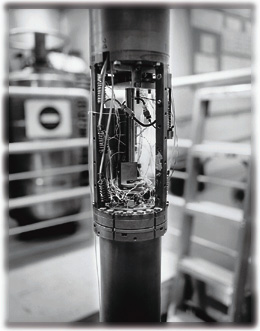Main Menu · Search · Current Issue · Contact · Archives · Centennial · Letters to the Editor · FAQs
![]()
Main Menu ·
Search · Current Issue · Contact · Archives · Centennial · Letters to the Editor · FAQs

| High School Physics: A Dead End? | Consuming Passions | |
| Cockpit Teamwork | Antimatter: Some Like It Cold | |
| E-mail and Web Information | ||
 Antimatter confinement apparatus that Harvard students and professors in Geneva used to store cold positrons and antiprotons simultaneously. Photograph by John Soares |
Yes, antimatter does exist. but if you're worried about going out for a walk, meeting your antimatter self, and then disappearing in a huge burst of energy, calm down. The stuff isn't available to the general public just yet.
Professor of physics Gerald Gabrielse has been trying to make cold antimatter for 10 years. He hasn't done it yet, but an experiment last December left him and his international team very close. "For the first time," Gabrielse says, "we put cold positrons and cold antiprotons in the same container and made them interact." Now all he needs is to get more of them to interact. The idea is to get two of the particles to come together and form an anti-hydrogen atom.
In the hypothetical antimatter universe, each of the three basic subatomic particles--protons, neutrons, and electrons--have corresponding antimatter particles, called antiprotons, antineutrons, and positrons, respectively. Each antimatter particle has the opposite sign of charge, but the same mass and same magnitude of charge, as its matter twin.
Antimatter does occur naturally. Radioactive decay can create some positrons, and occasionally, when a particle from outer space hits our atmosphere, the debris from the collision may contain some antiprotons. But these events are extremely rare. Hence, the need to study antimatter by making some from scratch. Logically enough, Gabrielse is starting with the simplest atom--hydrogen, which consists of one electron orbiting one proton. Anti-hydrogen is composed of a positron orbiting an antiproton.
Knowledge of the two antiparticles has been around for a while. After a 1928 theory predicted the existence of both, positrons were discovered in 1932 and antiprotons in 1955. Since 1987, Gabrielse has been learning how to capture and store these particles at a temperature only a few degrees above absolute zero. Now he is ready to take the next step.
Gabrielse won't be the first to make anti-hydrogen, but he will be the first to make it cold. The first anti-hydrogen atoms were made at CERN (Conseil européen pour la recherche nucléaire, the European Laboratory for Particle Physics) in Geneva in 1995. There were nine of them, they were hot (i.e. high-energy, fast-moving), and had a rather short life span: they blew apart after about 40 billionths of a second. Gabrielse remembers that heady time well: "For two days, I did nothing but answer the phone, and it wasn't even my experiment. That's the sort of fascination that people have with antimatter, probably because of Star Trek. Anyway, in science, you usually like to try and do something a little more real than just make a splash."
 The electronics of an antimatter trap. Liquid helium is above, the "bottle without walls" below. Photograph by John Soares |
Gabrielse's beef with the pioneering antiatoms was simply that they were too hot to handle. Antimatter can't be stored by traditional means--it tends to annihilate when it comes into contact with ordinary matter. What kind of jar would you keep that in? It has to be stored, as Gabrielse says, in "a bottle without walls"--an electromagnetic trap. Only the coldest particles can go into the trap. And only in the trap can they be studied.
Since he first trapped cold antiprotons in 1986, Gabrielse has been testing a fundamental theorem of physics: that antimatter has the same properties as regular matter. (If it does not, much of accepted physics will be stood on its head.) The primary test thus far has been to compare the charge-to-mass ratios of protons and antiprotons. The verdict? The ratios are the same, one part in a billion. Gabrielse is a little disappointed by this result, but not particularly surprised. "If we had discovered a difference," he says, "it would have been one of the most exciting discoveries in physics in many, many years."
Still, once Gabrielse has the actual antimatter in hand, he can put the theorem to some new tests. One involves shining various lasers at anti-hydrogen, measuring the energy level structure of the atoms and then comparing the results to ordinary hydrogen. Another involves observing the effects of gravity on antimatter. "People have speculated over the years that antimatter atoms might fall up," he says. "I don't think anybody really believes that now, but we certainly should be able to get enough accuracy to show explicitly that it doesn't happen."
The world will have to wait for these results until 1999 at the very earliest, when a new test facility in Geneva is scheduled to become operational. "In the first year we'll mostly be just getting our apparatus to work," Gabrielse says. "But we're going to take a shot at making some anti-hydrogen in 1999. Over the next few years we're going to get more and more accurate...I would be terribly surprised if this wasn't at least a 10-year project."
Is there a disintegration ray lurking around the corner--or perhaps, the truly ultimate diet? Probably not. Gabrielse foresees little or no direct practical application for this work. Still, sometimes you get lucky. "When you do these kinds of esoteric experiments, whose point is just to see how things are put together, you push the technology awfully hard," he says. "And when you push the technology awfully hard...well, sometimes you invent things."
~ Matt O'Keefe
Main Menu ·
Search · Current Issue · Contact · Archives · Centennial · Letters to the Editor · FAQs
![]()